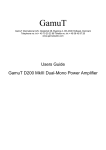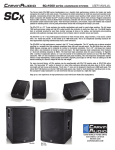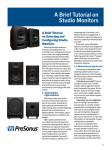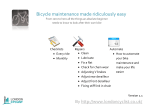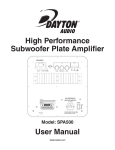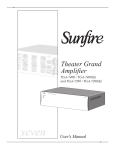Download Cinema Ribbon_3_RevA.indd
Transcript
Important Safety Instructions 1. Read Instructions. 2. Keep these Instructions. 3. Heed all Warnings. 4. Follow all Instructions. 5. Do not use this apparatus near water. 6. Clean only with a dry cloth. 7. Do not install near any heat sources such as radiators, heat registers, stoves, or other apparatus (including amplifiers) that produce heat. 8. Refer all servicing to qualified service personnel. Servicing is required when the apparatus has been damaged in any way, such as a connector is damaged, liquid has been spilled or objects have fallen into the apparatus, the apparatus has been exposed to rain or moisture, does not operate normally, or has been dropped. 9. Object and Liquid Entry — Care should be taken so that objects do not fall into and liquids are not spilled into the inside of the apparatus. WARNING: THIS LOUDSPEAKER IS CAPABLE OF PRODUCING VERY HIGH SOUND PRESSURE LEVELS. YOU MUST TAKE EVERY PRECAUTION TO PROTECT YOUR HEARING FROM PERMANENT DAMAGE. Contents Safety Instructions.........................................2 Introduction ...................................................3 Features ........................................................3 Overview .......................................................4 Rear Panel Features .....................................5 Biamping .......................................................6 Biwiring ........................................................7 Wall Mounting ...............................................8 Loudspeaker Locations ...............................10 Using a Subwoofer......................................12 Break-in Period ...........................................13 Specifications ..............................................14 Troubleshooting ..........................................14 Limited Warranty .........................................15 Service Assistance ......................................15 To find out more about this and other Sunfire products, please visit our website: www.sunfire.com 2 User's Manual Introduction Dear Friend: Thank you for purchasing a Sunfire XTSeries Cinema Ribbon Trio loudspeaker. We hope you enjoy it and the music it makes as much as we have enjoyed creating it for you. As an exclusive XT-Series product, this loudspeaker follows a great heritage of both world-class ribbon loudspeaker designs and industry-leading subwoofer technologies. The CRS-3 and CRS-3C loudspeaker are designed as a perfect match to our True Subwoofer series, resulting in the ultimate home theater experience... the kind of heart-felt experience that could only come from Sunfire. Unpacking Your Sunfire Cinema Ribbon Trio loudspeaker should reach you in perfect condition. If you do notice any shipping damage, please contact your Sunfire dealer immediately. Gently lift out the loudspeaker and remove the bracket hardware and all the packing material. It is important to save all the packing materials and the box in case your loudspeaker ever needs to be moved or shipped for repair. Make sure that you keep your sales receipt. It is the only way to establish the duration of your Limited Warranty and it may come in useful for insurance purposes. Please take a moment to fill out and mail the Sunfire Customer Response card. Also read the serial number located on the rear label and record it here: Features • CRS-3 loudspeaker for front, surround, and back surround applications • CRS-3C loudspeaker for center channel applications • 2 1/2 way, tapered array design • Magnetically shielded • Waveguide-loaded Neodymium ribbon • 4.5-inch High Back-emf drivers (three for the CRS-3, four for the CRS-3C) • 117 dB maximum output • 440 watts maximum power • Ebonized Rosewood finish • Biwire and Biamp capable • Two pairs of gold plated 5-way binding posts • Boundary switch compensates for differences in sound due to location near walls • Ebonized Rosewood finish • Wall mounting brackets supplied Care To maintain the loudspeaker cabinet’s finish, use a soft dry cloth to clean the surfaces. If your loudspeaker needs servicing, please read the Troubleshooting section on page 14. If a problem persists, please contact your nearest authorized Sunfire Dealer. Serial Number: Purchased from: Date: User's Manual 3 Overview The Cinema Ribbon Trios are high performance speakers that are specifically designed to work with your flat panel display. Sharing technology with the rest of the Cinema Ribbon line, years of research and decades of experience have gone into these amazing loudspeakers. The Cabinet The Cinema Ribbon Trios feature a carefully designed cabinet that stems from years of research into how the box affects the sound of the loudspeaker. The specialized facets of the Cinema Ribbon Trios result in a loudspeaker that is free of unwanted sonic bounces. The Ribbon - A Legacy Refined The ribbon in this loudspeaker is a remarkable piece of engineering, because it has the output capability, purity, and low distortion of a 6-foot tall ribbon - in fact, it is derived from Bob Carver’s award-winning Amazing Loudspeaker from the late 1970s! The sound from the CRS-3 ribbon is deliberately focused in the forward direction, with very little sound going up or down - reducing reflections off the ceiling and floor, that disturb the sense of space and imaging. The CRS-3C features an integrated “acoustic lens,” that disperses the signal for center channel applications. The Woofers - A Legacy Refined Sunfire created the category of small-box, high-power subwoofers more than a decade ago with the original True Subwoofer. This design relies on high-pressure, “High Back-emf” technology that provides very high bass output from a very small box. When migrating this subwoofer technology to the midrange and high frequencies on the Cinema Ribbon Trios, you get the same advantages: high output, small size, high efficiency, and years of trouble-free operation. Conclusion The Cinema Ribbon Trios are the most powerful speakers available today for flat panel display applications. Combine this with their specially designed cabinets and highefficiency ribbons, and you have the ultimate home theater experience. Are you ready? Happy listening! 4 User's Manual Rear Panel Features 2 1 3 2 CRS-3 Rear Connectors 1. Boundary Compensation Switch This switch compensates for bass and mid-bass loading that occurs when a loudspeaker is wall-mounted, compared to when it is away from a wall. Switch it to the left if your loudspeaker is close to a wall or other large objects that may cause reflections. Switch it to the right if the loudspeaker is placed more out into the room, such as when on a stand. Experiment with the switch to find the position that suits your preference. 2. Ribbon Binding Posts 3. Woofer Binding Posts The loudspeakers have two sets of binding posts that are joined with bridge clips (4) for normal operation. With the bridge clips in place, you can connect your amplifier outputs to either positive/negative pair of binding posts. Always use high quality connections and speaker wires, and make sure there are no loose fittings or stray wire strands. They will accept bare wire, pins, banana plugs and spade connections. User's Manual 1 3 CRS-3C Rear Connectors 4 Bridge Clips Connect the positive speaker-level output of your power amplifier or receiver to a positive (red) input of the loudspeaker. Connect the negative speaker-level output of your power amplifier or receiver to a negative (black) input of the loudspeaker. Make sure that the positive and negative connections do not touch, or this may damage your power amplifier. Tighten all four binding posts to make sure the bridge clips are making a good contact. 4. Bridge Clips From the factory, the two positive binding posts are electrically joined together with a bridge clip, as are the two negative posts. Leave the clips in place, unless you are considering biwiring or biamping. If the bridge clips are removed, the loudspeaker can be biwired or biamped. The ribbon posts (2) are then used for connection of speaker-level power to the ribbon section. The woofer posts (3) are for connection of speakerlevel power to the woofer section. (See the next two pages for more details.) 5 Biamping The loudspeakers have two sets of binding posts that can be used for biwiring or biamping. These posts are joined with bridge clips for normal operation. • Connect the amplifier’s right rear output to the right loudspeaker’s woofer input terminals. Connect the amplifier’s right front current source output to the ribbon input terminals. Make sure the bridge clips are removed from the loudspeakers when you want to biamp or biwire them. If not, this may cause damage to your amplifier.. • Both amplifier channels are fed with the same (right, front) line-level signal from your preamp. In a biamp system, each loudspeaker can be driven by two separate amplifier channels; one to drive the woofers and one to drive the ribbon. Biamping with a Sunfire Theater Grand Amplifier The front channels of Sunfire's Theater Grand Amplifiers each have two pairs of outputs. In a biamp system, use the current source to drive the ribbon and a separate channel's voltage source to drive the woofers. Conventional Biamping If you are not using a Sunfire Theater Grand Series amplifier (or you are using the current source outputs for something else), then connect separate amplifier channels to the woofer terminals and ribbon terminals. The amplifiers should be of identical power output and performance. Both amplifier channels are fed with the same linelevel signal from your preamp. This example shows the connections for biamping a right front speaker. Amplifier outputs Sunfire TGA Series Amplifier outputs 6 User's Manual Biwiring In a biwire system, each loudspeaker is driven by one amplifier channel, but separate speaker wire pairs are used for the woofer and ribbon connections. Make sure the bridge clips between the woofer and ribbon posts are removed from the loudspeakers when you want to biamp or biwire them. If not, this may cause damage to the amplifier. Biwiring with a Sunfire Theater Grand Amplifier • Connect the amplifier’s right front voltage source output to the right loudspeaker’s woofer input terminals. Use a separate pair of speaker cables to connect the amplifier’s right front current source output to the ribbon input terminals. Conventional Biwiring The example below shows the connections for biwiring a right front speaker from a single output binding post pair. The front channels of Sunfire's Theater Grand Amplifiers each have two pairs of outputs that can be used to biwire your speakers. The idea is to use the voltage source to drive the woofers, and the current source to drive the ribbon. This will offer improved performance. This example shows the connections for biwiring a right front speaker. Amplifier outputs • Connect the amplifier terminals to the loudspeaker's woofer input terminals, and use a separate speaker cable pair to connect the same amplifier terminals to the ribbon input terminals. Sunfire TGA Series Amplifier outputs User's Manual 7 Wall Mounting The CRS-3 loudspeakers can be wall mounted vertically, for example, on either side of a plasma display. We recommend that the ribbon section is positioned at a height close to ear-level, therefore you can fit the CRS-3 loudspeakers with the ribbon at the bottom if necessary. The CRS-3C center loudspeaker can be fitted horizontally, either above or below the plasma display. The following brackets and screw hardware are supplied with each loudspeaker: • Two small loudspeaker brackets • One wall bracket • Four screws and nylon washers to attach the loudspeaker brackets to the wall bracket • Four 1/4-20 x 5/16” screws and washers to attach the loudspeaker brackets to the loudspeaker • Three dry wall anchors and screws • We recommend that you locate the bracket onto a wall stud if possible. • If you have to mount the bracket onto a masonry wall, we recommend that you consult with your hardware supplier to buy suitable masonry hardware. If in doubt, please ask your Sunfire dealer to recommend a professional installer. • Put on your safety glasses. Procedure • Secure the loudspeaker brackets to the rear panel of the loudspeaker using the four 1/4-20 x 5/16” screws and washers supplied. The slotted holes in the side of the bracket should be down if you want the speaker to tilt up, or up if you want it to tilt down. • On the rear of the loudspeaker, set the Boundary Compensation switch to the "Wall" position. Tools required: • Phillips screwdriver • Pencil or other marker • Electric drill and 3/8" drill bit • Safety glasses • Sturdy ladder or step ladder • Electronic stud finder if needed. • You may need an assistant to help with the last steps. Preliminary steps: 8 • Remove any speaker wires from the loudspeaker. • Clear the area where you are going to work, so it will be safe. Remove any fragile objects, small children or pets, and cover anything that might be affected by dust from drilling. User's Manual Mounting onto dry wall • Place the wall bracket in position on the wall. Use your pencil to mark the three holes. Use the built-in bubble level to make sure the bracket is level. • With a 3/8" drill bit, drill three through-holes into the marked positions on the wall. Remove any dust or particles. • Press a dry wall anchor into each hole, and gently tap them in flush. • After tapping the anchors flush, each screw needs to be fully tightened so the anchor collapses and holds itself to the wall. Then remove the screws and offer up the wall bracket. • Fit the wall bracket to the wall and tighten the three screws firmly by hand, so the bracket is secured to the wall (and so the loudspeaker will not vibrate on the wall). User's Manual Final Procedure • Connect your speaker wires to the back of the loudspeakers, making sure of the correct polarity. • Hold the loudspeaker in place, so the side holes in the loudspeaker brackets line up over the side holes of the bracket on the wall. • Have your assistant insert the four screws with nylon washers, and loosely secure the loudspeaker brackets to the wall mount bracket. • Adjust the tilt as desired, and then tighten the four screws securely. • Test the loudspeakers and enjoy! 9 Loudspeaker Locations The details below show various systems incorporating the loudspeakers, with a subwoofer to handle the low frequency range. Ideally, all of the surround loudspeakers in a home theater system should be of the same make and model, and positioned at similar heights to produce a smooth and continuous soundfield. The Cinema Ribbon Duos (CRM-2) use the same drivers and ribbons as the Trios, making them perfect for rear channel applications. The loudspeakers are a perfect sound compliment to a plasma display. The CRS-3C center loudspeaker can be mounted above or below the display, and the CRS-3 can be mounted at either side. If you have a Sunfire or Carver system equipped with Sonic Holography, then it is recommended that you use a tape measure to set the left and right loudspeakers to be an equal distance away from your listening position, within half an inch tolerance. (Sonic Holography is a unique process designed by Bob Carver to enhance the three-dimensional effects and realism of stereo sound.) The Center Loudspeaker Most movie dialog will come from the center loudspeaker, so careful positioning is an important part of a good home theater system. Your eyes and ears should focus your attention towards the center of the display. Set the Boundary Compensation switch to "Room" if the loudspeakers are away from the walls, such as on speaker stands. Front Left/Right Speakers The front left and right CRS-3 loudspeakers should be positioned so that your TV display is exactly centered between them. This will help focus your attention towards the display. Center loudspeaker The CRS-3C center loudspeaker can above, or directly underneath the display, as long as it is located on the centerline and not off to one side. Position the front face of the loudspeaker close to the front edge of the display. (The sound waves may otherwise reflect off the top of the display and distort the center imaging.) Front left and right loudspeakers Your left loudspeaker should be set exactly the same distance and angle away from your listening position as the right loudspeaker. If you have a smaller display, the loudspeakers should be no more than two feet away from the sides of the display. 10 If possible, have the center, left and right loudspeakers at the same height (within two feet). This will help give a smooth transition when sound effects move from loudspeaker to loudspeaker. We recommend that you keep the CRS-3C grill on, as it is part of the acoustic lens design of the center loudspeaker. User's Manual The CRM-2 ribbon loudspeakers may be used as surround loudspeakers, or you can use the CRS-3 as shown in the following systems and illustrations. 5.1 Configuration Place each surround loudspeaker an equal distance away from your central listening position, and keep them at least one or two feet above ear level (with you sitting down). 6.1 System With two surround back loudspeakers, set the surround back loudspeakers behind and between the surround loudspeakers. 5.1 System They can be placed behind the listening position, on the rear walls or the side walls. You can also experiment with “toeingin” the speakers slightly, to direct the high frequencies to the listening position. 6.1 and 7.1 Configuration Sunfire home theater processors and receivers have two extra outputs for surround back loudspeakers. These create a wonderful sense of realism in surround effects during playback of Dolby Digital EX, Dolby Pro Logic IIx, and DTS-ES. Such systems can be configured for one or two surround back loudspeakers. 7.1 System 9.1 Configuration Sunfire home theater processors and receivers have two side-axis channels that are matrixed from the left and right front channels, and they are available in stereo as well as surround modes. Place the side-axis loudspeakers along the side walls, close to the fronts. You can also angle them in towards your listening position. If you are connecting one surround back loudspeaker, place it directly behind your listening position and move the surround loudspeakers to the side as shown. 9.1 System User's Manual 11 Subwoofer Location The best location for a single subwoofer can be found by following these steps: 1. Place the subwoofer on your couch or favorite easy-listening chair. 2. You can then either run a calibration (noise) signal through it, or play some of your favorite music samples with heavy bass. 3. 12 Walk around the room, standing in all the positions where you might be able to place the subwoofer. This is usually somewhere close to the corners of the room. Try locations fairly close to the front loudspeakers, and try crouching down low. 4. Find the place in the room where the bass output from the subwoofer is most even. Shut things down and install the subwoofer there. 5. This is the best position for the subwoofer. The bass will sound the best when you are sitting in your normal listening position. Using a subwoofer The Cinema Ribbon Trio loudspeakers are designed to be used with a subwoofer to fill in the lower frequency range. They are not designed to accept 440 watts of power at the full frequency range. Your system should be designed so that the Cinema Ribbon Trio loudspeakers receive only the range above 80 Hz, with a subwoofer to handle the frequencies below 80 Hz. Sunfire home theater processors and receivers have a bass management system that allows you to redirect the bass frequency range of each channel to the subwoofer. The advantages are : • The overall bass of the system is improved, as subwoofers, such as Sunfire's powered True Subwoofers are specially designed for this frequency range. • The subwoofer can simultaneously play the bass from all of the loudspeakers, in addition to it’s own low frequency effects channel (LFE). • There is no loss in perception of the position of movie or music sound effects, as the ear cannot easily locate the position of bass sound sources. • Compact loudspeakers can be used for front, center and surrounds, as they do not have to reproduce the low frequency range. This leads to a saving in room space. • Your amplifiers do not waste power reproducing the low frequency range. User's Manual Crossover adjustment We recommend that you set your home theater processor's crossover to 80 Hz, and set the channels that use the Cinema Ribbon Trio loudspeakers to "small." • Your subwoofer receives frequencies below 80 Hz, from all loudspeakers whose size is set to small, in addition to the LFE channel: NOTE: If your processor or preamplifier does not have a crossover control, you might need an external active crossover to split the audio signal into a low-pass range for the subwoofer, and a highpass range for the Cinema Ribbon Trios. (Sunfire subwoofers have their own crossover controls with line-level highpass outputs that can be used to power an amplifier connected to Cinema Ribbon Trio loudspeakers.) Break-in period • • All loudspeakers set to small, receive frequencies above 80 Hz: Set your subwoofer's own crossover control (if it has one) to maximum frequency or bypassed mode. (If it is set lower than the 80 Hz, there would be a hole in the mid-bass, and bass information would be missing.) The acoustic summation of the subwoofer output and the Cinema Ribbon Trio output produces a flat frequency response. Like many high performance automobiles, the Cinema Ribbon Trio loudspeakers perform at their best after an initial break-in period. A minimum of 20 hours is recommended prior to performing critical listening, however the speakers will sound their best after a period of 300 to 400 hours. During this time, the driver suspensions and ribbon structure will relax into their operating design positions and give optimum performance. To facilitate break-in during the initial 20 hours, it is recommended that you play material with a wide dynamic range at louder volumes – such as your favorite rock and roll album (that is if your family or neighbors can stand it). It is important that your amplifier must supply good clean power, and not run into distortion. Amplifier distortion due to clipping, causes high-frequency output components that can damage loudspeakers. Even a 100 watt amplifier running into clipping can damage loudspeakers rated at 400 watts or more. NOTE: Dolby Digital and DTS modes are designed especially for complete systems with front, center, and surround loudspeakers and subwoofers. You need all of the loudspeakers to get the best performance from your Home Theater. If you do not have a subwoofer connected, you will be missing the 5.1 LFE (low frequency effects) information. User's Manual 13 Specifications Troubleshooting The Cinema Ribbon Trio loudspeakers are designed and built to provide years of trouble-free performance. Most problems that occur can usually be solved by checking your setup, or by making sure all components are fully operational. The following information will help you deal with common problems you may experience. If a problem persists, please contact your Dealer for assistance. Design 2 1/2 way, Tapered Array Magnetically Shielded Drive Units HF: Waveguide loaded Neodymium Ribbon LF: 4.5-inch High Back-emf Frequency Response 80 Hz to 40 kHz Crossover Frequency Poor or no sound • Check all the connections from the loudspeaker to the amplifier or receiver. Swap loudspeakers around, and see if the poor sound follows a particular loudspeaker. • Check that your amplifier is not driven too hard or is clipping. Even a low-powered amp driven into clipping can cause distortion or damage your loudspeakers. • Many processor/preamps can send test tones through all the loudspeakers in your system. Use this to adjust the volume of each channel until they are all playing at the same level. Make sure that any bass management options are set correctly, and any channels using the Cinema Ribbon Trios are set to "small." • If the system bass is weak only when playing surround sources, check that your processor is correctly set to decode the surround modes, such as Dolby Digital or DTS. • Some DVD discs have a menu that allows you to select which soundtrack to play. Check that the correct surround audio soundtrack is selected. • Check the Bridge Clips are tight. 250 Hz to 1.5 kHz Maximum Power 440 watts Minimum Power 25 watts Sensitivity (2.83 V/1 meter) 89 dB Maximum Output 117 dB Impedance 6 ohms nominal Connections 2 pairs gold plated 5-way binding posts Finish Ebonized Rosewood Dimensions (with grill) CRS-3 Height Width Depth Weight CRS-3C Height Width Depth Weight 5.82" (148 mm) 24" (610 mm) 3.75" (96 mm) 15.8 lbs (7.2 kg) 5.82" (148 mm) 28" (711 mm) 3.75" (96 mm) 19.8 lbs (9 kg) © 2007 Sunfire Corporation. All rights reserved. Sunfire Corporation reserves the right to improve its products at any time. Therefore, specifications are subject to change without notice. Manual 913-139-00 Rev A 14 User's Manual Limited Warranty Sunfire Corporation is proud of its products which have been built with care using advanced technology and premium component parts. Your unit has been crafted to perform properly for many years. Sunfire Corporation offers the following Warranty to you, the owner of a new Sunfire product: The Sunfire Corporation Warranty for the XT-Series Cinema Ribbon Trio loudspeaker is in effect for FIVE years from the date of original retail purchase. The Sunfire Corporation Warranty covers defects in materials and workmanship. The following, however, are excluded: a) Damage caused during shipment. b) Damage caused by accident, misuse, abuse of operation contrary to the instructions specified in the Sunfire Corporation user’s manual c) Units where the serial number has been defaced, modified or removed, d) Damage resulting from modification or attempted repair by any person not authorized in writing by Sunfire Corporation. e) Units purchased from unauthorized dealers. The Sunfire Corporation Warranty extends to the original owner or subsequent owner(s) during the five year warranty period so long as the original dated purchase receipt is presented whenever warranty service is required. All implied warranties, including warranties or merchantability and fitness for particular purposes, are limited in duration to the five year length of this Warranty, unless otherwise provided by state law. Sunfire Corporation’s liability is limited to the repair or replacement, at our option, of any defective product and shall not in any event include property or any other incidental or consequential damages which may result from the failure of this product. User's Manual Some states do not allow limitations on how long an implied warranty lasts and/or do not allow the exclusion or limitation of incidental or consequential damages, so the above limitations or exclusions may not apply to you. This Warranty gives you specific legal rights, and you may also have other rights which vary from state to state. We suggest that you attach your purchase receipt to this Warranty and keep these in a safe place. Thank you for your choice of a Sunfire Corporation product. Service Assistance We suggest that you read the Limited Warranty completely to fully understand your Warranty/Service coverage. If your Sunfire Corporation product ever requires service, write to us, or call: Sunfire Corporation Technical Services Department P.O. Box 1589 Snohomish, WA 98290 [email protected] Tel (425) 335-4748 Fax (425) 335-4746 You will be directed to an authorized Sunfire Corporation Service Station or receive instructions to ship the unit to the factory. Please save the original shipping carton and packing materials in case shipping is required. Please do not ship Parcel Post. NOTE: Before sending in your unit for repair, you must call Sunfire for return authorization (RA). Include a complete description of the problem, indicating how you have it connected, the associated equipment in your system and a copy of your purchase receipt. Initial shipping costs are not paid by Sunfire Corporation; return ground shipping costs will be prepaid if repairs were covered by the scope of this Warranty. 15



















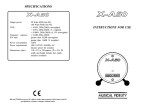

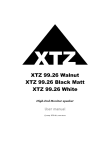

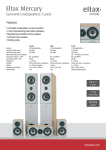
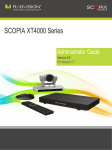
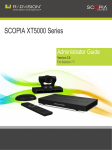
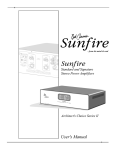
![PS manual[P].qXp2](http://vs1.manualzilla.com/store/data/005858764_1-0e0b40902f5a565498b3e3a041c7e706-150x150.png)
